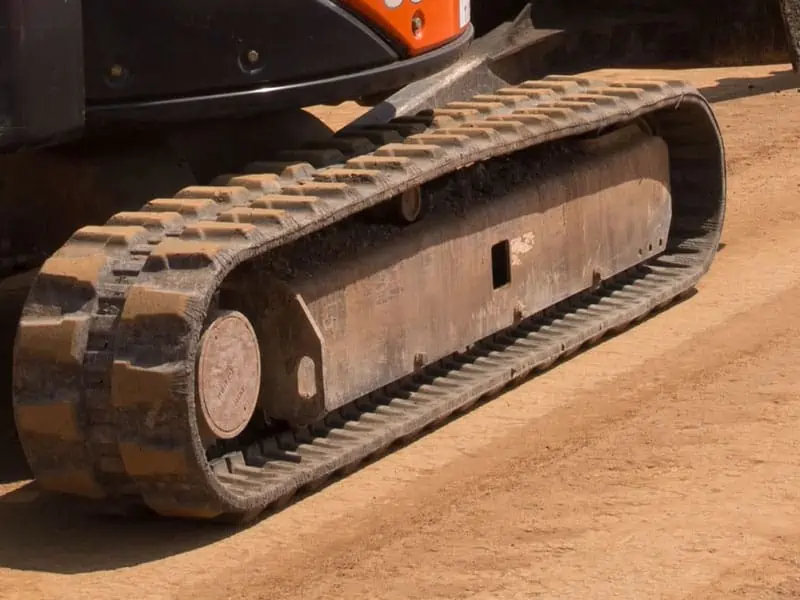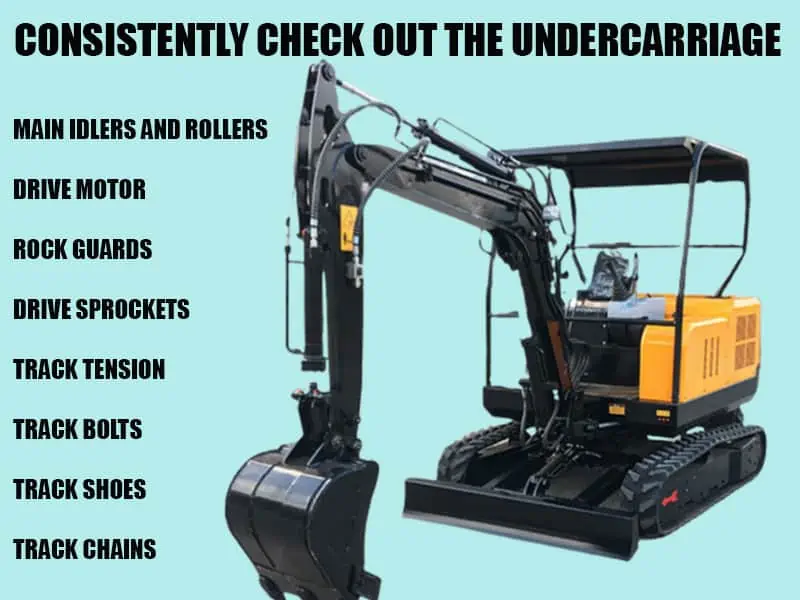What Causes Undercarriage Damage in mini excavators, and how to fix them? The undercarriage is a significant part of mini excavators or heavy equipment. The excavator component is robust and built to resist some of the most challenging conditions. However, damage to the undercarriage is not always avoidable. However, damage to the undercarriage is not always avoidable.
Various factors can cause undercarriage damage in mini excavators over the year. A lot is weighing on a compact excavator’s undercarriage. And when it comes to lowering the cost of equipment ownership, then proper care and maintenance can save from costly repairs.
Usually, a mini excavator does not take a lot of travel time. On a Jobsite, its primary function may be to sit and spin on its housing, digging holes, and trenches. Due to the lack of motion, there is less fatigue and wear on the undercarriage of the mini excavator compared to other machines.
However, as you know, it is the most costly part of the tracked equipment; it is imperative for operators to understand the parts and components, how to make up the undercarriage, and frequently monitor them that everything is working correctly. This post will briefly describe the causes of undercarriage damage in a mini excavator.
Table of Contents
ToggleWhat is Undercarriage Damage in Mini Excavators?

The undercarriage of a mini excavator or heavy equipment supports the framework underneath heavy machinery. There are different types of undercarriages, including rubber track undercarriages and machinery steel undercarriages. An undercarriage has many different parts, like tracks or wheels, assembled and attached to the undercarriage to help it move over different terrain.
Other vital components are frames, pins, idlers, rollers, sprockets, bushings, and links. The component is crucial to a piece of equipment’s functionality. But what is undercarriage damage? It is any damage that has occurred to the supporting structure underneath a piece of mini excavator.
So the undercarriage of heavy equipment is very important; its damage can be a massive cause of concern, accounting for some costly repairs. There are a lot of different factors or conditions that can cause damage to an excavator undercarriage.
What Are the Causes of Undercarriage Damage in Mini Excavators?

At a certain level of the undercarriage, the damage is unavoidable for most pieces of heavy equipment over time; it is still essential to be aware of the leading causes to prevent as much damage as possible. Here are the most common causes of mini excavator or heavy equipment undercarriage damage.
1. Water and Moisture
The undercarriage should be covered with a protective finish for water exposure as all parts of the machine. But the finish will only sometimes be practical. The undercarriage usually experiences more scratches at work, while the other parts, compared to the rest of the parts, the protective finish will wear off even quicker.
Hence, when the undercarriage gets exposed to water often without the chance to dry properly, the moisture will start to interact with the metal and lead to corrosion. Finally, corrosion leads to metal weakening and premature wear.
2. Rough Terrain
The more prominent cause of undercarriage damage is rough or uneven terrain. It is usually easy to tell when your small excavator has driven over large holes or dips in the ground. Usually, worksites have rough patches that significantly impact your heavy equipment.
While driving over a hole or other rugged, uneven surfaces, the ground can cause cracks in the undercarriage, leading to leaks. The damaging exposure to rough terrain can include rocks and other construction site debris.
Whenever you strike rocks, rubber tire pieces, or any other debris while operating the machines, it can cause damage to the undercarriage. Site rocks can fly up from work and cause punctures, nock bolts, and other parts to lose. So always drive cautiously on sites with lots of debris and unsteady and uneven terrain.
3. Wrong Operation
Using your mini excavator beyond its operating capacity can cause stress to its undercarriage. Use on sloped surfaces needs a lot of power that puts strain on track shoes, rollers, and segments. When you make sharp movements instead of wide turns, fastly wears out tracks.
4. Mud Residue
Mud residue has a huge problem in some areas and causes a lot of damage to the undercarriage. If you do not wash off the mud from the undercarriage properly, it can hold moisture, eventually leading to rust and bushing failure.
How to Prevent Undercarriage Damage in Mini Excavators?
Premature failure in any equipment is often a result of poor maintenance. Regular maintenance of the mini excavator and other components, and inspections on your equipment’s undercarriage to identify issues before they become major problems and prevent many issues from arising in the first place. So Damage prevention has:
Regular Inspections:Before using your equipment, you should Inspect it carefully, paying attention to parts such as the bearing seals, bolts, chains, rollers, segments, and rock guards. As you inspect, look out for any parts that are missing.
In addition, stick to a regular plan for greasing parts, tightening bolts, and performing test drives on new terrain, so you will always have equipment that operates at its best.
Cleaning:
- Give yourself enough time to clean your equipment at the end of each day.
- Clear out any debris before it hardens or freezes overnight.
- Use a shovel to break down large chunks of debris, and follow up with a power washer to clean hard-to-reach places.
Scheduled Maintenance:You should follow the maintenance schedule as the manufacturer suggested. Regularly bring your machines to professional mechanics, even when usually working, so they can guide you in avoiding minor issues turning into costly problems.
Seek Professional Guidance:Ask a professional to measure the wear and tear on your undercarriage every 2000 hours.
Careful Operation:Avoid human error by using your equipment according to its specifications. These types of terrain you operate on and clear the worksite of mud and harsh gravel whenever possible.
How to Fix Undercarriage Damage in Mini Excavators?

If you realize your mini excavator’s undercarriage is damaged. When you safely remove your small excavator from the work site, inspect the undercarriage for any visible damage.
If you doubt that you have caused an issue by driving over uneven terrain or pushing it beyond its capacity, stop operations immediately; if you notice the oil is coming from bushings or your mini excavator is noisier than usual, vibrating or challenging to control, immediately consult professional help. To fix this damage, we offer you some tips:
1: Keep the Undercarriage Clean
After completing the day’s work, the excavator operator should take time to clean out dirt and other debris that can result in undercarriage buildup. You can use shovels and pressure washers to clean the undercarriage.
Because if you do not clean the undercarriage regularly, it will accelerate premature wear and tear on components. Especially true in colder climates. The mud, dirt, and debris will freeze if operators do not clean the undercarriage and work in a colder climate. It can start to rub on the bolts, loosen the guiding and seize up the rollers. So Cleaning the undercarriage is a necessary point.
2: Consistently Check Out the Undercarriage
It is crucial to complete an undercarriage checkout for excessive or uneven wear and look for damaged or missing components. The undercarriage can need to be inspected more frequently. You should inspect these items daily:

In a routine inspection, walk around your excavator, and check the tracks to see if any components look out of place. It will indicate a loose trackpad or possibly a broken track pin if you notice. If there is any oil lake, these oil leaks will indicate a failed seal which can lead to a significant failure in the rollers, idlers, or track drive motors.
3: Follow the Manufacturer’s Recommendations
Following the manufacturer’s recommendations is very important to save the undercarriage harms of a mini excavator. As you know, Certain construction Jobsite tasks can create more wear and tear on excavator tracks and undercarriages, so operators must follow the manufacturer’s recommended operating procedures.
When you move the machine up or down a hill, ensure the drive motor is in the correct position to reduce track wear. Rough asphalt, concrete, or other abrasive materials can cause damage to tracks. Track select the proper shoe width by considering the machine’s weight and application.
4: Maintain Proper Track Tension
Wrong track tension can result in increased track wear, so it is crucial to take proper tension. When your operators are working in soft, muddy conditions, running the tracks slightly looser is recommended.
5:Use Rubber Tracks for Soft Surfaces
Rubber tracks are available on mini excavators, and these models excel in various uses. Rarely rubber tracks give good flotation, allowing excavators to travel across and work on soft ground. The rubber tracks have minimal ground disruption on finished surfaces like concrete, grass, or asphalt.
6: Act on Proper Digging Process
Mini Excavator operators should follow basic operating Processes in the manufacturer’s operation and maintenance manual to minimize excessive wear and track abasement. The undercarriage makes up a large portion of track replacement costs. It consists of expensive components.
The verdict
For more information about undercarriage damage in mini excavators, contact us today.
